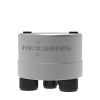Sequoia LISST-ABS Acoustic Sediment Sensor
Features
- Uses acoustic backscatter to measure the concentration of particles suspended in water
- Wide dynamic range of concentrations from 1mg/L to 30 g/L
- Plug-and-play interface with X-Series data loggers and telemetry systems
- Expedited repair and warranty service
- Lifetime technical support
- More
Overview
The Sequoia Scientific LISST-ABS is a single-point acoustic sediment sensor, designed to provide higher quality data than optical turbidity sensors. The LISST-ABS internally measures the Attenuation Corrected Backscatter (ACB). The ACB value is converted to an Uncalibrated Concentration (Cu) and then output. To convert the Uncalibrated Concentration to sediment concentration, a simple multiplier is required. The multiplier, or Cal Factor, is dependent on the specific type and size of sediment being measured. When a user recalibrates an instrument, this multiplier is updated.
Mechanics
The Sequoia Scientific LISST-ABS employs a high frequency of 8 MHz. Calibration of backscatter signal strength with sediment concentration remains nearly constant over a wide particle size range, ~40-500 microns. Over this size range, the Sequoia Scientific LISST-ABS calibration changes only about ~±30%. In contrast, over this same size range, optical turbidity sensors would change calibration by ~ ±600% over its mean value.
Remote Monitoring
The LISST-ABS sensor offers a plug-and-play interface to the NexSens X3 data loggers and telemetry systems. The X3 is available for pole-mount deployments with solar charging or connected to the SBP500 submersible alkaline battery pack for subsurface deployments.
- Frequency: 8 MHz
- Sample Volume: 10mm dia x 15mm L (located 5.5 cm in front of sensor)
- Resolution: 0.5 % of reading
- Range: 1 mg/L to 30 g/L (7 micron dust) or <20 g/L (200 micron sand)
- Calibration: Recommended with sediment samples
- Sensor Diameter: 2.00 in (5.08cm)
- Length: 13.25 in (33.65cm)
- Weight: 1 lb. (0.5Kg) in air; 0.5 lb. (0.22Kg) buoyant in water
- Transducer: 8mm dia, ceramic
- Power Supply: 9 to 18 VDC, 100 mA
- Maximum Depth: 100m
- Material: ABS Plastic
- Connector Type: Impulse MCBH-8-MP-SS
- Power on LED: Green, blink on update
- Sample Update Rate: 1Hz (average of 1000 measurements)
In The News
2025 Essential Water Monitoring Gear
Stay ahead of the curve with five of the top water monitoring products for 2025. Technological advancements and manufacturing innovations are leading to better quality data, improved price points, and enhanced user experience. And, while the ‘essentials’ list includes several new products, two tried-and-true measurement instruments continue to take a top spot for portable instrumentation. These five products were developed by industry-leading suppliers, and in addition to extensive manufacturer testing, our science team tested and verified each instrument’s performance at the Fondriest Center for Environmental Studies .
Read MoreYSI ProDSS Multi-Parameter Water Quality Meter Review
There's no shortage of options when it comes to water quality monitoring equipment. If you're looking for an all-in-one multi-parameter sampling meter, then the YSI ProDSS is a prime choice. Along with its field-rugged construction, backlit display, rechargeable battery, a wide selection of cable lengths and a long list of measurement parameters, the meter offers the latest in smart sensor technology. Constructed of titanium and laser welded, the smart sensors offer superior performance in fresh, brackish and saltwater applications. Upon connection, the smart sensors are automatically displayed on the meter. With internally stored calibration constants, any sensor can plug into any port and provide accurate data in just seconds.
Read MoreMonitoring Hurricanes and Predicting Flooding in the Age of Climate Change
Still recovering from Hurricane Helene, which caused extreme precipitation, flooding, landslides, and other environmental disasters associated with severe weather, the southeastern part of the U.S. is predicted to be hit by another storm, Hurricane Milton. With Hurricane Helene having made landfall only a little over a week ago on September 27 th , many communities are still recovering. ABC reports that over 230 people have been killed as a result of flooding and destruction caused by Helene, with many still missing. Residents in these heavily impacted states, such as Florida, Georgia, South Carolina, North Carolina, Virginia and Tennessee, are still searching through the rubble of homes, urban centers, and hospitals for loved ones and belongings.
Read More






















